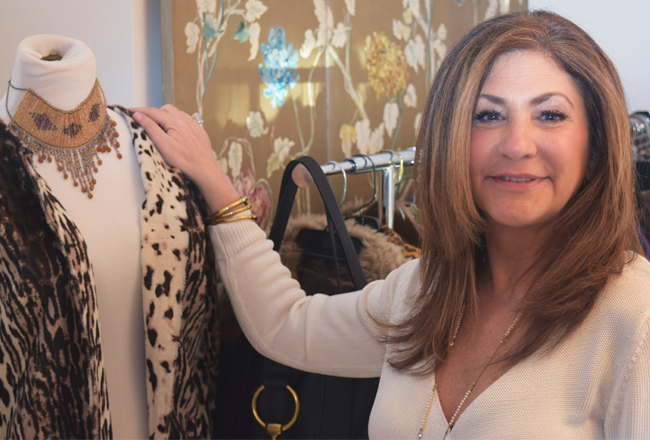Lynn Cesaria and the pursuit of dressing for success and style
During her interview with the Business Journal, fashion stylist Lynn Cesaria looked at the red-and-black plaid shirt I was wearing and asked how many more plaid shirts I had in my closet. When told her this was the sole plaid shirt in my wardrobe, she exhaled a sigh of relief and smiled.
“People tend to buy the same things over and over and over,” she said. “I go through people”™s closets first and I see the same thing hanging in every color, but it is the same version. One client had 32 blouses that were all the same cut ”” it did nothing for her.”
With a 25-year-plus career spanning work as fashion illustrator, photographer, personal shopper and stylist, Cesaria uses her Southport-based consultancy Lynn Cesaria Style to dress men, women and teenagers. And while the concept of a personal fashion stylist might seem to be a luxury for the very wealthy, Cesaria stated that her services span the socioeconomic spectrum.
“I have clients who are on a budget,” she said. “I dress people who are average working people, house moms, kids. People think a stylist is for very wealthy people. It is for everybody who is not happy with the way they look when they look in the mirror.”
For Cesaria, the core challenge comes in trying to determine and encourage the aesthetic style that matches a client”™s personality and environment.

“Style is something that is almost innate ”” it”™s within you,” she continued. “It”™s not something that you can really learn. I don”™t like overdone. I think the clothes should make you look spectacular and I always say that when somebody compliments you and says ”˜Gee, what a great outfit you have on,”™ you want them to say, ”˜I love you in that outfit,”™ not ”˜I love the outfit but it”™s not suiting you.”™ ”
Not every garment in the stores is ideal quality. Cesaria noted that “American designers cut larger and European designers cut smaller,” and many highly regarded brand names were sold to manufacturers and are not representative of the designers”™ best-known work.
“A lot of designers have skimped on quality of fabric and clothing,” she said. “I buy things from designers that are a lot older ”” the stitching and the fabrics are amazing.”
There is also the challenge of dealing with a population that, on the whole, is physically larger than previous generations. But Cesaria insisted that carrying a few extra pounds (or more) does not disqualify someone from looking their best.
“The way to hide your flaws is to focus on the best parts of you,” she said. “You”™re not hiding anything if you”™re wearing a muumuu. If you”™re overweight and you”™re wearing a tent, people are going to guess there”™s weight under there. I dress women and men who are slightly larger in fitted clothing that enhances their body.”
Cesaria found men to be “more stuck in their patterns, more than women.” And while shirts and ties are easy to buy for me, she acknowledged that getting the best suits are “a little harder to buy” and she consults with designers on dressing her male clients for success. For some of her female clients, Cesaria often finds herself moving the women away from a long-held style that is not flattering.
“I ease people out of their comfort zone,” she said. “If I”™m doing a closet clean out, I get rid of a lot of unwanted stuff. A client would say, ”˜Oh, I love that blouse.”™ And I say, ”˜But not on you, sweetheart.”™ ”
With her female clients, Cesaria is more conservative when it comes to jewelry. “It has to be done right,” she stated. “There is a definite thought process. So, if I wear big earrings, I”™ll do a long necklace. If I am wearing a bell sleeve, I”™m not going to wear a bracelet because it”™s not going to show. You don”™t want to look like you”™re advertising for a jewelry store or a department store. You just want the right accessories.”
Cesaria did not consider wearing designs or styles from different cultures to be an act of cultural appropriation, provided the garment was worn correctly and respectfully.
“Every culture has its own fashion or look,” she said. “But if I wanted to wear an Asian-style jacket, why not? Let”™s remember, all of our clothing comes from everywhere. For example, Julie Christie wore a fur hat in ”˜Doctor Zhivago”™ ”” I have the same fur hat.”
Cesaria was also adamant that looking good does not end with the close of the workday and the start of the home leisure hours.
“You can be in schlubby clothes on a Sunday, but they can be nice schlubby clothes,” she said. “If you”™re in your sweats and there are stains on it ”” when you walk past the mirror, don”™t you feel a little grungy? But if you are wearing the same sweats that fit you a little better and have no stains on them, you walk by the mirror and go, ”˜Yeah, I”™m rockin”™ it, even in my sweats.”™ ”
Cesaria”™s work is also preparing the next generation of fashionistas and she admitted always being happy when a teenager she was contracted to style responds to her insight and suggestions.
“Teens do not listen to their mother, but when a fashion stylist comes in and says, ”˜That”™s not what you should be wearing,”™ they listen,” she said. “And mothers say to me, ”˜She never listens to me like that.”™ And I say, ”˜Well, I”™m not genetically related.”™ ”